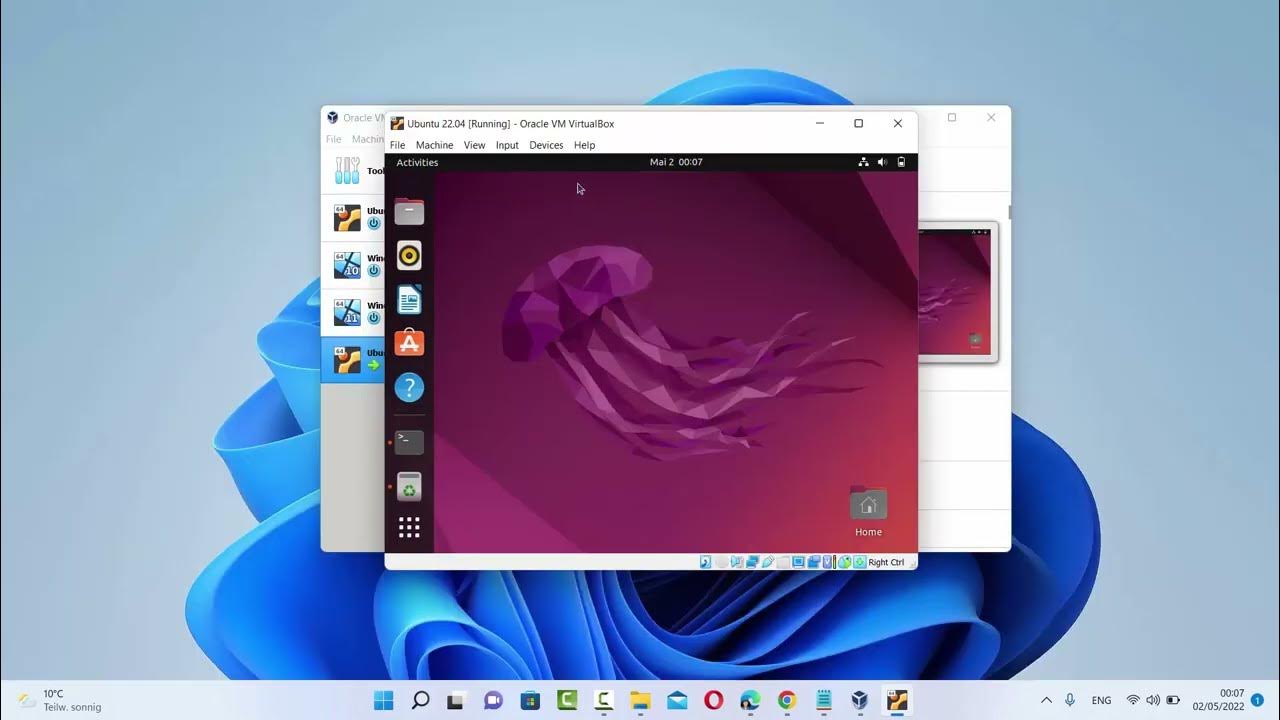Cara Install Sistem Operasi Linux Ubuntu di Virtualbox
Summary
TLDRThis video tutorial provides a step-by-step guide on installing Ubuntu Linux on VirtualBox. The presenter explains how to download and install VirtualBox, get the Ubuntu ISO file, and set up a virtual machine. The installation process is demonstrated, including language selection, disk configuration, and user setup. By the end of the video, viewers will have a fully functional Ubuntu system running on VirtualBox. This easy-to-follow guide is ideal for anyone wanting to try Linux in a virtualized environment without altering their main operating system.
Takeaways
- 😀 The video provides a step-by-step guide on installing the Linux operating system, specifically Ubuntu, on VirtualBox.
- 😀 The first step is to download and install VirtualBox using a web browser, such as Google Chrome, by searching for 'VirtualBox' and selecting the appropriate download option for your operating system.
- 😀 After installing VirtualBox, the next step is to download an ISO file of Ubuntu from the official Ubuntu website, selecting either the LTS or the latest version of Ubuntu.
- 😀 The installation process is demonstrated with VirtualBox running on Windows 10, showing how to select the ISO file during the setup of the virtual machine.
- 😀 The tutorial recommends configuring the virtual machine's hardware settings, including adjusting the amount of RAM and CPU resources according to your system's capabilities, ensuring they stay within the 'green' range for optimal performance.
- 😀 The virtual hard disk size is also set during the setup process. The video suggests 25 GB as a sufficient size, but you can increase it if needed.
- 😀 After setting up the virtual machine, the user starts the machine, selecting 'Try or Install Ubuntu' during boot to begin the installation process.
- 😀 The guide emphasizes selecting the correct time zone (e.g., Jakarta, for Indonesia) and configuring the system's keyboard layout during the installation process.
- 😀 During installation, the user chooses 'Normal Installation' and opts to download updates and install third-party software for improved functionality.
- 😀 The final steps include setting up a username and password for logging into the newly installed Linux system, with the password being critical for future logins and administrative tasks.
- 😀 Once the installation is complete, the user is guided through restarting the virtual machine and logging into the Ubuntu desktop environment, ready to use for personal or professional purposes.
Q & A
What is the first step to install Linux on VirtualBox?
-The first step is to download and install VirtualBox. This can be done by visiting the official VirtualBox website and choosing the version for your operating system (e.g., Windows 10).
How do you download the Ubuntu ISO file for installation?
-To download the Ubuntu ISO, go to the official Ubuntu website, search for the 'Download Ubuntu' page, and choose either the LTS version (22.04.3) or the latest version (23.10). In the video, the presenter selects the LTS version.
Can I install VirtualBox on an operating system other than Windows 10?
-Yes, VirtualBox is available for various operating systems, including Windows, macOS, and Linux. The installation steps are similar for all platforms, but you need to download the version that corresponds to your operating system.
What should I do after downloading the VirtualBox installer?
-After downloading the VirtualBox installer, double-click the file to start the installation. Follow the on-screen instructions and click 'Next' until the installation is complete.
How do you create a new virtual machine in VirtualBox?
-Once VirtualBox is installed, open the application and click 'New' to create a new virtual machine. You will need to name the machine and select the ISO file of the operating system you want to install.
What hardware settings need to be configured for the virtual machine?
-For the virtual machine, you need to allocate RAM and set the size for the virtual hard disk. The presenter in the video uses 1.8 GB of RAM and a 25 GB hard disk, which are sufficient for running Ubuntu.
How do I select the correct ISO file during the setup of the virtual machine?
-During the virtual machine setup in VirtualBox, click on the 'Settings' button and browse to the location where you saved the ISO file. Select the ISO file and click 'Open' to link it to the virtual machine.
What options should be selected during the Ubuntu installation process?
-During the installation, select 'Install Ubuntu' and choose the keyboard layout, time zone, and installation preferences. The video demonstrates choosing the 'Normal Installation' option and enabling both updates and third-party software.
What user information is required during the Ubuntu installation?
-During installation, you need to provide your name, computer name, username, and a password. The password will be used to log in to the system after installation.
How long does the installation process take, and what factors affect the speed?
-The installation process can take several minutes to an hour, depending on your internet speed and the performance of your computer. Faster internet and a more powerful computer will result in a quicker installation.
Outlines

This section is available to paid users only. Please upgrade to access this part.
Upgrade NowMindmap

This section is available to paid users only. Please upgrade to access this part.
Upgrade NowKeywords

This section is available to paid users only. Please upgrade to access this part.
Upgrade NowHighlights

This section is available to paid users only. Please upgrade to access this part.
Upgrade NowTranscripts

This section is available to paid users only. Please upgrade to access this part.
Upgrade NowBrowse More Related Video
5.0 / 5 (0 votes)





